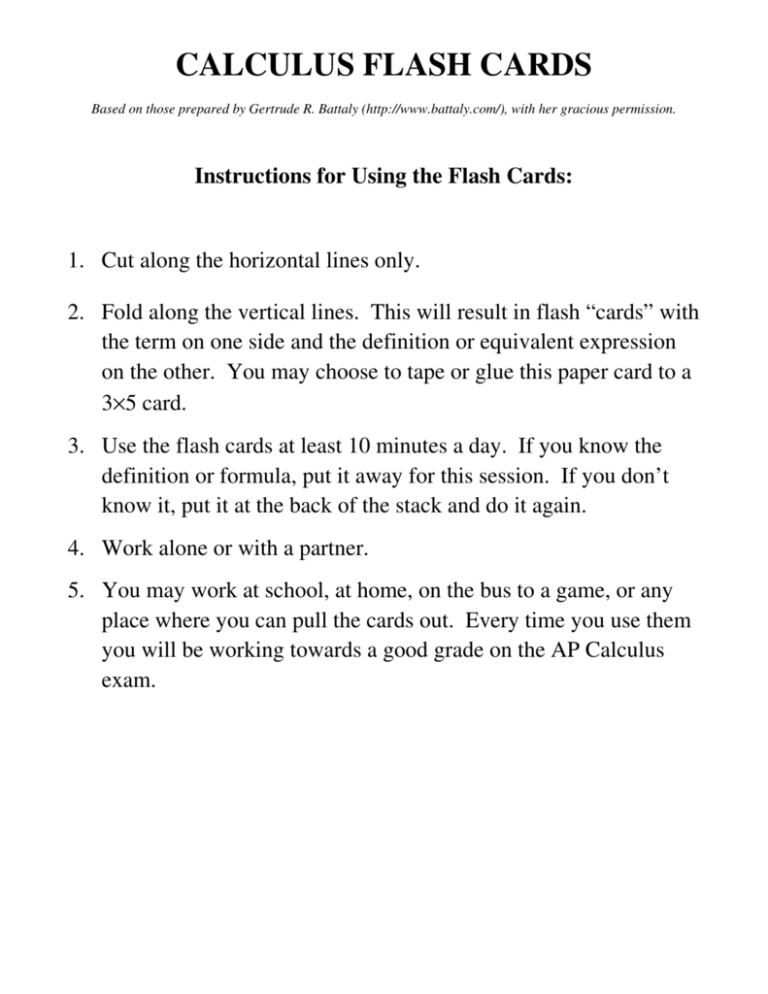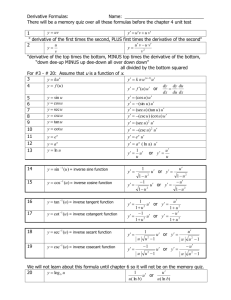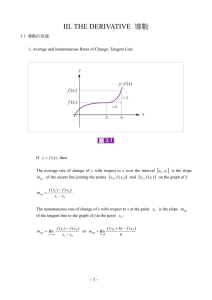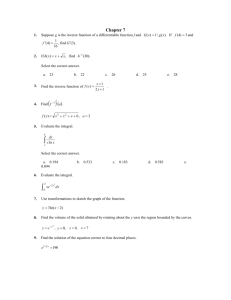Calculus flash cards
advertisement

CALCULUS FLASH CARDS Based on those prepared by Gertrude R. Battaly (http://www.battaly.com/), with her gracious permission. Instructions for Using the Flash Cards: 1. Cut along the horizontal lines only. 2. Fold along the vertical lines. This will result in flash “cards” with the term on one side and the definition or equivalent expression on the other. You may choose to tape or glue this paper card to a 3×5 card. 3. Use the flash cards at least 10 minutes a day. If you know the definition or formula, put it away for this session. If you don’t know it, put it at the back of the stack and do it again. 4. Work alone or with a partner. 5. You may work at school, at home, on the bus to a game, or any place where you can pull the cards out. Every time you use them you will be working towards a good grade on the AP Calculus exam. sin 0 0 π 1 2 sin sin sin sin 6 π 4 π 3 π 2 1 2 = 2 2 3 2 1 sin π 0 3π 2 –1 sin 2π 0 cos 0 1 sin cos π 6 3 2 cos cos cos π 4 π 3 π 2 1 2 = 2 2 1 2 0 cos π –1 3π 2 0 cos cos 2π 1 tan θ sin θ cos θ (in terms of sine and/or cosine) cot θ (in terms of sine and/or cosine) csc θ (in terms of sine and/or cosine) sec θ (in terms of sine and/or cosine) cos θ sin θ 1 sin θ 1 cos θ y 1 x −π −π/2 π/2 π 3π/2 2π Graph of y = sin x −1 y 1 x −π −π/2 π/2 π 3π/2 2π Graph of y = cos x −1 y 2 1 x −π −π/2 π/2 π 3π/2 2π Graph of y = tan x −1 −2 y 2 1 x −π −π/2 π/2 π 3π/2 2π Graph of y = sec x −1 −2 4 y 3 2 1 x −4 −3 −2 −1 1 −1 −2 −3 −4 2 3 4 Graph of y = 1 x y 2 1 Graph of y = x −2 −1 1 2 3 4 x 5 −1 y 1 Graph of y = 1 − x 2 x −1 1 4 y 3 2 1 Graph of y = x x −4 −3 −2 −1 −1 1 2 3 4 −2 −3 −4 y 3 2 1 x −4 −3 −2 −1 1 2 3 4 5 Graph of y = ln x −1 −2 −3 y 3 2 1 x −4 −3 −2 −1 1 −1 −2 −3 2 3 4 5 Graph of y = ex Definition: An even function is… …symmetric with respect to the y-axis, like y = x2, y = cos x, or y = x . f (–x) = f (x) Definition: An odd function is… …symmetric with respect to the origin, like y = x3, y = sin x, or y = tan x. f (–x) = –f (x) Two formulas for the area of a triangle 1 A = bh 2 1 A = ab sin C 2 Formula for the area of a circle A = πr2 Formula for the circumference of a circle C = 2πr Formula for the volume of a cylinder V = πr2h Formula for the volume of a cone 1 V = π r 2h 3 Formula for the volume of a sphere 4 V = π r3 3 Formula for the surface area of a sphere A = 4πr2 Point-slope form of a linear equation y – y1 = m(x – x1) sin x x →0 x 1 1 − cos x x →0 x 0 Definition: A tangent line is… …the line through a point on a curve with slope equal to the slope of the curve at that point. Definition: A secant line is… …the line connecting two points on a curve. Definition: A normal line is… …the line perpendicular to the tangent line at the point of tangency. lim lim Definition: f(x) is continuous at x = c when… Limit definition of the derivative of f(x): f ′(x) = Alternate definition of derivative of f at x = c: f ′(c) = 1. f(c) exists; 2. lim f ( x) exists; and x→c 3. lim f ( x) = f (c) x→c lim ∆ x →0 f ( x + ∆x ) − f ( x ) ∆x lim x →c f ( x ) − f (c ) x−c • slope of curve at a point What f ′(x) tells you about • slope of tangent line a function • instantaneous rate of change Definition: Average rate of change is… ∆y f ( b ) − f ( a ) = ∆x b−a Power rule for derivatives: d n x )= ( dx nx n−1 Product rule for derivatives: d ( f ( x) g ( x) ) = dx f ′(x)g(x) + g′(x)f(x) = 1st · d(2nd) + 2nd · d(1st) Quotient rule for derivatives: d f ( x) = dx g ( x ) g ( x) f ′( x) − f ′( x) g ( x) ( g ( x )) 2 lo ⋅ d hi − hi ⋅ d lo = lo ⋅ lo f ′ ( g ( x ) ) ⋅ g ′ ( x ) , or Chain rule for derivatives: derivative of the outside d f ( g ( x )) function times derivative dx of the inside function ( d ( sin x ) = dx ) cos x d ( cos x ) = dx –sin x d ( tan x ) = dx sec2x d ( cot x ) = dx –csc2x d ( sec x ) = dx sec x tan x d ( csc x ) = dx –csc x cot x 1 d ( arcsin x ) = dx d ( arccos x ) = dx 1 − x2 − d ( arcsec x ) = dx 1 − x2 1 1 + x2 d ( arctan x ) = dx d ( arccot x ) = dx 1 − 1 1 + x2 1 x x2 −1 d ( arccsc x ) = dx 1 − x x2 −1 Derivative of natural log: d ( ln x ) = dx 1 x Derivative of log base a: d ( log a x ) = dx 1 x ln a Derivative of natural exponential function: d x e )= ( dx ex Derivative of exponential function of any base: d x a )= ( dx a x ln a 1 Derivative of an inverse ; −1 f ′( f ( x )) function: d The derivatives of inverse f −1 ( x ) ) = ( dx functions are reciprocals. Rolle’s Theorem: If f is continuous on [a, b], differentiable on (a, b), and… Mean Value Theorem for Derivatives: If f is continuous on [a, b] and differentiable on (a, b), then… … f(a) = f(b), then there exists c ∈ (a, b) such that f ′(c) = 0. there exists a value of c ∈ (a, b) such that f (b ) − f ( a ) . f ′(c) = b−a … f must have both an Extreme Value Theorem: absolute maximum and an If f is continuous on a absolute minimum on the closed interval, then… interval. Intermediate Value Theorem: If f is continuous on [a, b], then… … f must take on every y-value between f (a) and f (b). If a function is differentiable at a point, then… … it must be continuous at that point. (Differentiability implies continuity.) Four ways in which a function can fail to be differentiable at a point • Discontinuity • Corner • Cusp • Vertical tangent line Definition: A critical number (a/k/a critical point or critical value) of f(x) is… …a value of x in the domain of f at which either f ′(x) = 0 or f ′(x) does not exist. If f ′(x) > 0, then… … f(x) is increasing. If f ′(x) < 0, then… … f(x) is decreasing. If f ′(x) = 0, then… … f(x) has a horizontal tangent. Definition: f(x) is concave up when… f ′(x) is increasing. Definition: f(x) is concave down when… f ′(x) is decreasing. f ″(x) > 0 means that f(x) is… concave up (like a cup) f ″(x) < 0 means that f(x) is… concave down (like a frown) Definition: A point of inflection is a point on the curve where… … concavity changes. To find a point of inflection,… … look for where f ″ changes signs, or, equivalently, where f ′ changes direction. To find extreme values of … f ′ is zero or undefined a function, look for (critical numbers). where… At a maximum, the value of the derivative… … f ′ changes from positive to negative. (First Derivative Test) At a minimum, the value of the derivative… … f ′ changes from negative to positive. (First Derivative Test) The Second Derivative Test: If f ′(x) = 0 and… …f ″(x) < 0, then f has a maximum; if f ″(x) > 0, then f has a minimum. ∫ v ( t ) dt , the Position function s(t) = antiderivative of velocity Velocity function v(t) = s′(t), the derivative of position, as well as ∫ a ( t ) dt , antiderivative of acceleration Acceleration function a(t) = v ′(t), the derivative of velocity, as well as s″(t), the second derivative of position A particle is moving to the left when… …v(t) < 0. A particle is moving to the right when… …v(t) > 0. A particle is not moving (at rest) when… …v(t) = 0. A particle changes direction when… …v(t) changes signs. To find displacement of a particle with velocity v(t) from t = a to t = b, calculate this: To find total distance traveled by a particle with velocity v(t) from t = a to t = b, calculate this: b ∫ v ( t ) dt a b ∫ v ( t ) dt a right Area between curves Volume of a solid with cross-sections of a specified shape ∫ ( top − bottom ) dx left b ⌠ area of cross-section dx ⌡a ∫ Volume using discs b a π r 2 dx “perpendiscular” Volume using washers (discs with holes) Volume using shells b ∫ (π R a ∫ b a 2 − π r 2 ) dx 2π rh dx “parashell” Area of a trapezoid Trapezoidal rule for approximating ∫ b a f ( x)dx A= 1 h ( b1 + b2 ) 2 1 ≈ h ( y0 + 2 y1 + 2 y2 + 2 +2 yn−1 + yn ) Average value of f(x) on [a, b] 1 b f ( x)dx ∫ b−a a Power rule for antiderivatives: n x ∫ dx = x n+1 +C n +1 (for n ≠ –1) Constant multiple rule for k ∫ f ( x ) dx antiderivatives: (A constant coefficient can be brought outside.) ∫ kf ( x ) dx = ∫ sin x dx = –cos x + C ∫ cos x dx = sin x + C 2 sec ∫ x dx = tan x + C 2 csc ∫ x dx = –cot x + C ∫ sec x tan x dx = sec x + C ∫ csc x cot x dx = –csc x + C ⌠ dx = ⌠ 1 dx = ⌡ x ⌡x ln x + C x e ∫ dx = ex + C ⌠ dx = 2 ⌡ 1− x arcsin x + C ⌠ dx = ⌡ 1 + x2 arctan x + C L’Hôpital’s rule for indeterminate limits f ( x) 0 ∞ If lim = or , x →c g ( x ) ∞ 0 f ( x) f ′( x ) then lim = lim x →c g ( x ) x →c g ′ ( x ) if the new limit exists. Mean Value Theorem for …there exists a c ∈ [a, b] Integration: such that If f(x) is continuous 1 b f(c) = f ( x ) dx ∫ on [a, b], then… b−a a Fundamental Theorem of Calculus (part 1) d x f ( t ) dt = ∫ a dx f (x) Fundamental Theorem of F(b) – F(a), where F is an Calculus (part 2) b antiderivative of f f x dx = ∫ ( ) a A differential equation is… …an equation containing one or more derivatives. To solve a differential equation,... ...first separate the variables (if needed) by multiplying or dividing, then integrate both sides. Exponential Growth and Decay: dy If = ky , then… dt y = Cekt, where C is the quantity at t = 0, and k is the constant of proportionality. b ∫ ( rate of change ) dt = a the amount which that quantity has changed from t = a to t = b







